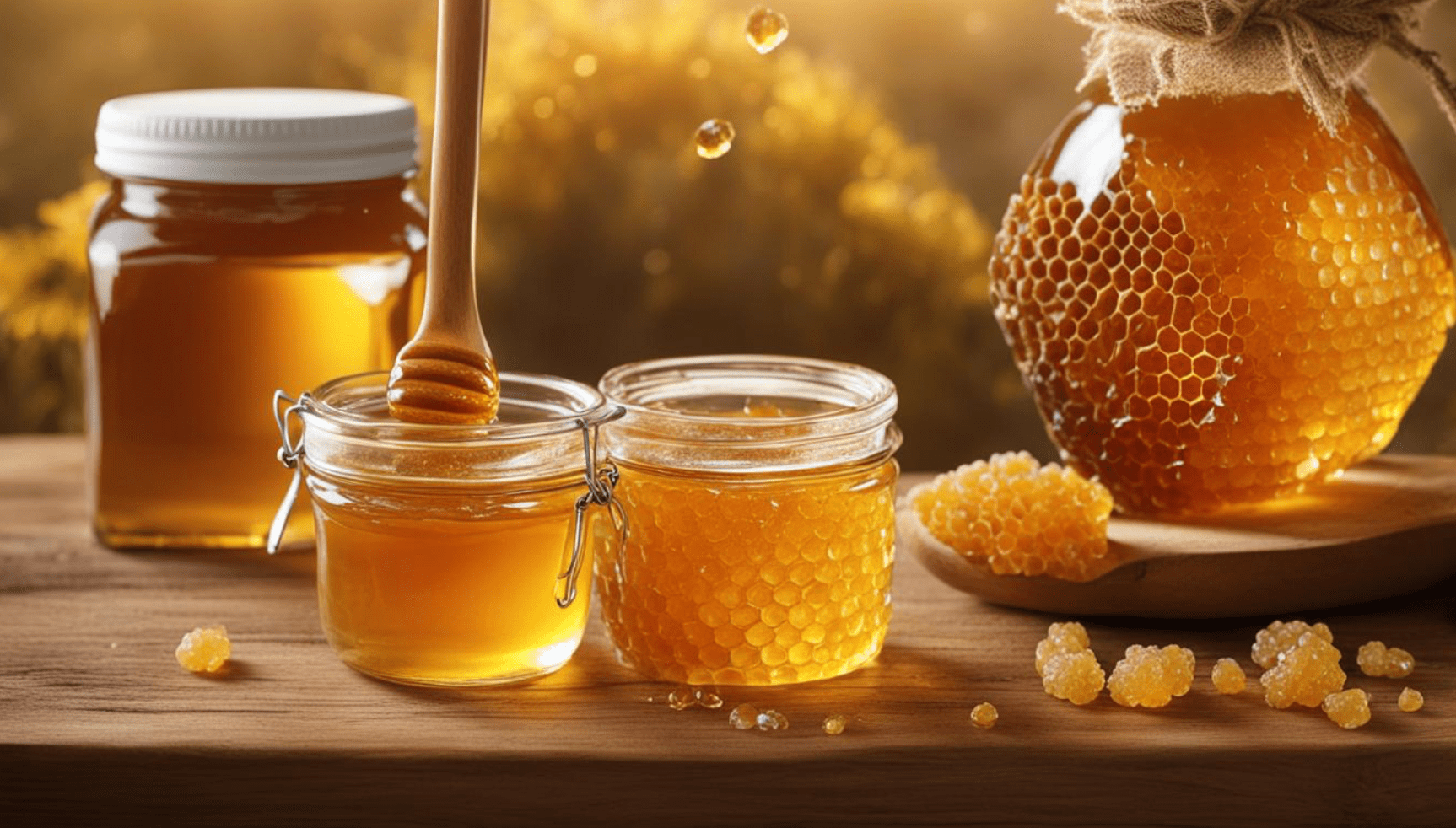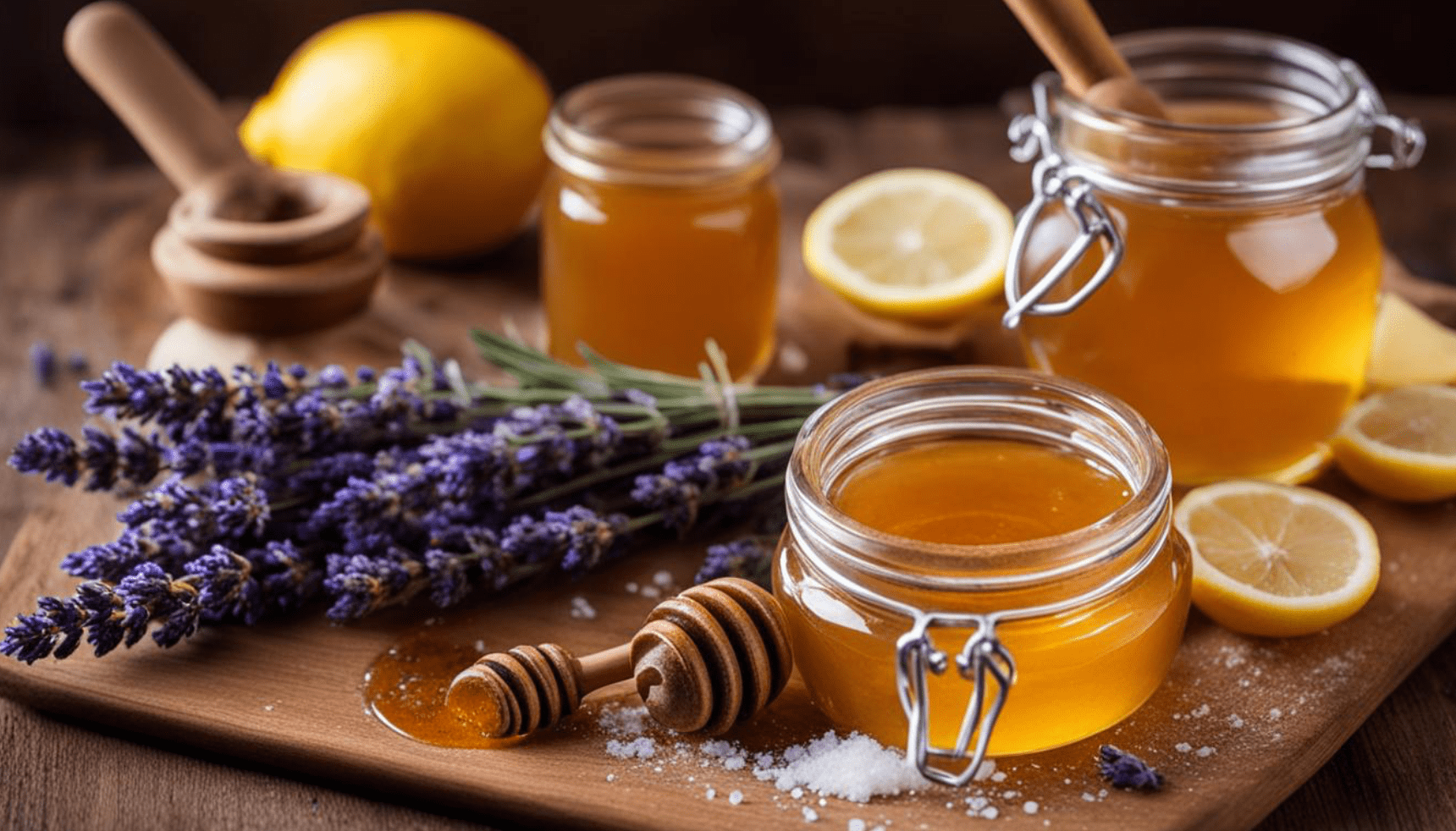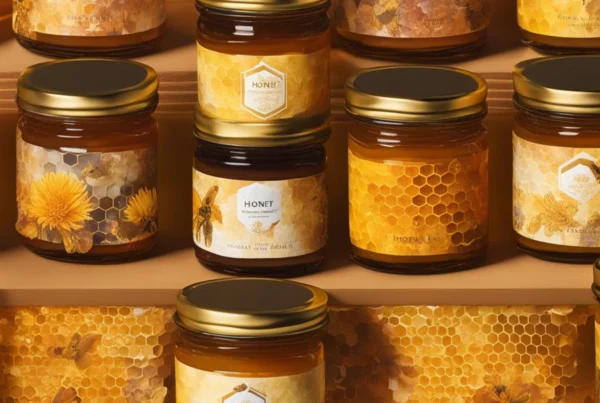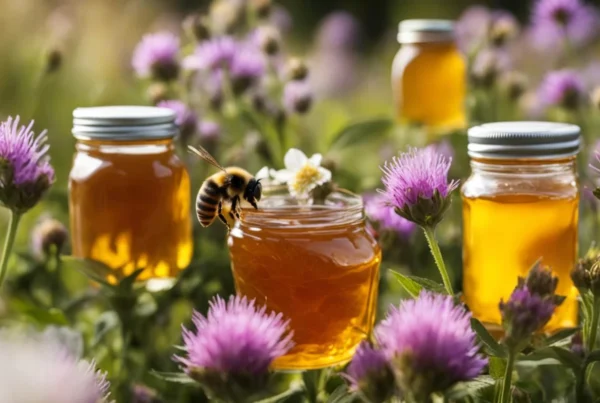Have you ever looked at a jar of honey and noticed that it has turned cloudy and grainy? This phenomenon is known as honey crystallization, which is a natural process that occurs in most types of honey. As a result, crystallized honey tends to have a thicker texture and a granulated appearance, unlike liquid honey that pours smoothly.
Honey crystallization is not an indication of spoilage or decreased quality, but rather a sign of its natural composition. Crystallization signifies that the honey is raw and unprocessed, and still contains small particles of wax, pollen, and propolis, which are all beneficial compounds for human health. In this article, we will explore the science behind honey crystallization, its benefits, and how to maintain the purity and quality of honey.
Key Takeaways:
- Honey crystallization is a natural process that occurs in most types of honey.
- Crystallization does not signify spoilage or decreased quality.
- Crystallized honey tends to have a thicker texture and a granulated appearance, unlike liquid honey.
- Crystallization signifies that the honey is raw and unprocessed, and still contains small particles of wax, pollen, and propolis.
- In this article, we will explore the science behind honey crystallization, its benefits, and how to maintain the purity and quality of honey.
The Science Behind Honey Crystallization
Honey crystallization occurs when the natural sugars in honey separate and form crystals, resulting in a grainy texture and opaque appearance. This natural process is caused by the glucose in honey, which can come out of solution and turn into crystals over time.
The rate of honey crystallization depends on several factors, including the floral source of the honey, its moisture content, and storage conditions. Honey with higher glucose levels and lower water content is more likely to crystallize quickly.
Factors Contributing to Honey Granulation
Several factors contribute to honey granulation, including:
- Glucose content: Honey with a higher percentage of glucose is more likely to crystallize.
- Water content: Honey with lower water content is more prone to crystallization.
- Temperature: Honey stored at cooler temperatures will crystallize faster.
- Storage container: Honey stored in metal containers or those with rough or porous surfaces can promote crystallization.
Despite its granular texture, crystallized honey is still safe to consume and has the same nutritional benefits as liquid honey. In fact, some people prefer the texture and spreadability of crystallized honey.
Preventing Honey Crystallization
While honey crystallization is a natural process that cannot be completely prevented, there are some ways to slow it down:
- Store honey in a warm location, ideally between 70-80°F (21-27°C).
- Keep honey in a tightly sealed container to prevent moisture from entering.
- Avoid storing honey in metal or porous containers.
- If honey crystallizes, gently warm the jar in warm water or a microwave to liquefy it, being careful not to overheat and destroy the enzymes and beneficial compounds in the honey.
Understanding the science behind honey crystallization can help you appreciate it as a natural and normal process. Whether you prefer liquid or crystallized honey, both are delicious and full of valuable nutrients.
Benefits of Crystallized Honey
While some people may be put off by the grainy texture of crystallized honey, it actually has several benefits worth considering. Here are some of the top advantages of consuming crystallized honey:
| Nutritional Benefits | Health Benefits |
|---|---|
| Higher antioxidant properties: According to a study published in the Journal of Agricultural and Food Chemistry, crystallized honey contains more antioxidants than liquid honey. | Improved digestive health: The coarse texture of crystallized honey can act as a natural prebiotic, promoting the growth of beneficial gut bacteria and aiding in digestion. |
| Longer shelf life: Crystallized honey has a longer shelf life than liquid honey, as the sugar crystals prevent yeast and bacteria growth. | Reduced blood sugar spikes: The slower digestion of crystallized honey can lead to a more controlled release of glucose into the bloodstream, reducing blood sugar spikes. |
It’s important to note that the nutritional benefits of crystallized honey can vary depending on the floral source and processing methods used.
“Crystallized honey has a unique flavor and texture that can enhance the taste of many different foods, from toast to yogurt to baked goods.”
Overall, while the personal preference for honey texture may vary, there are clear benefits to consuming crystallized honey. It’s worth giving this natural process a try and enjoying the unique flavor and texture it offers.
Maintaining Honey Purity and Quality
Proper storage and preservation of honey can help maintain its purity and quality. It is important to follow certain guidelines to prevent honey from becoming crystallized. Here are some tips to ensure you store and preserve your honey correctly:
Honey Storage
Store honey in a cool, dry place away from direct sunlight. Exposure to heat and light can cause honey to crystallize and lose its flavor and nutritional value. Also, make sure to keep honey in a tightly sealed container to prevent moisture from entering and affecting its quality.
Honey Preservation
Proper preservation of honey is crucial for maintaining its purity and quality. Avoid adding water or any other substances to honey as it can create a favorable environment for fermentation and spoilage. It is also important to use clean utensils when handling honey to prevent contamination.
When buying honey, make sure to choose a reputable brand that follows industry standards for honey production and storage. Look for the terms “pure honey” or “raw honey” on the label to ensure you are getting a high-quality product.
Understanding Honey Texture and Consistency
Honey is a natural product that comes in different textures and consistencies, ranging from liquid to creamy and crystallized forms. The texture and consistency of honey can affect its taste and usability, making it essential to understand how these factors vary.
The texture of honey refers to its physical properties, including the amount of air bubbles, thickness, and stickiness. The consistency of honey, on the other hand, is the degree of thickness, fluidity, or hardness. The composition and processing of honey influence its texture and consistency, resulting in different forms.
Liquid Honey
Liquid honey is the most common type, with a runny consistency and a smooth, evenly spreadable texture. It usually comes from the nectar of flowers, trees, or other plants and has not undergone any significant processing.
Liquid honey is usually light-coloured and has a mild, delicate flavour. It is suitable for use in tea, cooking, and baking, as it blends easily with other ingredients and spreads evenly.
Creamy Honey
Creamed honey (also known as whipped or spun honey) is a type of honey that has undergone a controlled crystallization process. It is created by combining a small amount of already crystallized honey into a liquid honey and slowly stirring it until the crystals become evenly dispersed.
The result is a smooth, creamy texture that is easy to spread. Creamy honey is popular among consumers who prefer a thicker, more spreadable consistency for their toast, bagel, or pancakes.
Crystallized Honey
Crystallized honey is a natural process that occurs when glucose in honey precipitates out of the liquid into crystals, forming a hard, grainy texture. This process is influenced by several factors, including the floral source of honey, temperature, and length of storage.
Crystallized honey is usually less runny and has a more solid, grainy texture than liquid honey. It usually has a lighter colour than liquid honey, and its flavour may be more intense. Crystallized honey is often preferred by consumers who like to spread it on toast or use it as a natural sweetener in tea or coffee. It is also popular for its long shelf life and resistance to spoilage.
Understanding the different types of honey texture and consistency can help you choose the best type of honey for your needs, whether it’s for cooking, baking or spreading. Keep in mind that the texture and consistency of honey can vary depending on the factors that influence its production.

“Honey crystallization is a natural process that occurs when glucose in honey precipitates out of the liquid into crystals, forming a hard, grainy texture.”
How to Liquefy Crystallized Honey
Crystallized honey can be a nuisance when you want to use it as a spread or sweetener. Luckily, there are several ways to liquefy crystallized honey without damaging its natural properties. Here are some methods to try:
1. Warm Water Bath
To liquefy crystallized honey, place the jar of honey in a warm water bath. Fill a bowl or sink with warm water (not hot) and place the jar in it, ensuring that the water level is below the lid. Leave the jar in the water for 10-15 minutes, and then stir the honey. Repeat the process until the honey reaches the desired consistency. Be careful not to overheat the honey, as this can damage its nutritional properties.
2. Oven Method
You can also use an oven to liquefy crystallized honey. Preheat your oven to 150°F (65°C) and turn it off. Place your jar of crystallized honey in the warm oven, with the lid off. Leave the honey in the oven for about 30 minutes and then stir it. Repeat the process until the honey is fully liquefied. Again, be careful not to overheat the honey.
3. Microwave Method
Another option is to use a microwave to liquefy crystallized honey. Remove the lid and foil seal from the jar and place it in the microwave. Heat the honey on high power for 30 seconds, or until it starts to liquefy. Stir the honey and then heat it for another 30 seconds. Repeat the process until the honey is fully liquefied. Be careful not to overheat the honey in the microwave, as it can easily burn.
Regardless of the method, it’s important to note that liquefied honey may crystallize again over time. You can prevent this by storing the honey in a cool, dry place and avoiding rapid temperature changes.
Preventing Honey Crystallization: Strategies and Methods
Preventing honey crystallization can help maintain its texture, consistency, and flavor. Here are some strategies and methods to keep your honey liquid and fresh:
- Control temperature: Store honey at temperatures between 50-70°F. Avoid exposing it to temperatures above 80°F, which can speed up the crystallization process.
- Choose the right container: Use glass or plastic containers with airtight lids to prevent moisture from getting into the honey. Avoid metal containers, as they can react with the honey and cause off-flavors.
- Store in a dry place: Keep honey in a dry place away from humidity and moisture. Humidity can contribute to the growth of bacteria and yeast, which can cause fermentation and spoilage.
- Use airtight packaging: Use airtight packaging, such as plastic wrap or airtight jars, to prevent air from getting into the honey. Oxygen can promote crystallization and spoilage.
- Stir the honey: Stirring or agitating the honey can help slow down crystallization by breaking down the sugar crystals. However, over-stirring can also introduce air into the honey and promote spoilage.
- Use anti-crystallization agents: Some anti-crystallization agents, such as creamed honey or corn syrup, can help slow down the crystallization process. However, they can also alter the flavor and texture of honey.
When Crystallization Occurs: How to Liquefy Crystallized Honey
If your honey has already crystallized, you can easily liquefy it using gentle heating techniques:
- Hot water bath: Place the honey jar in a pot of hot water and stir it occasionally until the crystals dissolve. Be sure not to overheat the honey, as it can affect its flavor and texture.
- Microwave: Microwave the honey jar for 30 seconds to 1 minute on low power, then stir it until the crystals dissolve. Repeat as needed until the honey is fully liquefied.
- Slow cooker: Place the honey jar in a slow cooker on low heat for a few hours, or until the crystals dissolve. Stir occasionally to ensure even heating.
- Oven: Preheat your oven to 150°F and place the honey jar in the oven for 30 minutes to 1 hour, or until the crystals dissolve. Be sure to monitor the honey and stir it occasionally.
Factors Affecting Honey Crystallization
Several factors can influence the crystallization of honey, including the floral source, moisture content, and storage conditions.
The floral source is the primary factor affecting the crystallization rate and texture of honey. Some types of honey, such as clover and acacia, are less likely to crystallize due to their low glucose content. Other honeys, such as wildflower and heather, contain more glucose and are more prone to crystallization.
Moisture content also plays a significant role in honey crystallization. Honey with a higher water content tends to crystallize more quickly than drier honey. This is because glucose molecules are more likely to bond together into crystals in a high-moisture environment.
Storage conditions can also affect honey crystallization. Honey stored at cooler temperatures (between 50-70°F) is more likely to crystallize than honey stored at warmer temperatures. Additionally, exposure to air and light can contribute to the breakdown of honey’s enzymes and lead to crystallization.
Proper honey storage and preservation techniques, such as storing honey in a cool, dry place and keeping it tightly sealed, can slow down the crystallization process and help maintain the quality of the honey. However, it’s important to note that crystallization is a natural process, and honey that has crystallized is still safe to eat and retains all of its nutritional benefits.
Conclusion
Understanding honey crystallization is essential for honey producers and consumers alike. It is a natural process that occurs when glucose and fructose molecules combine to create sugar crystals in the honey. While crystallized honey may not look as appealing as liquid honey, it is still a nutritious and delicious sweetener.
Benefits of Crystallized Honey
Crystallized honey has several benefits, including enhanced antioxidant properties and improved digestive health. The antioxidants in honey are believed to help protect the body against cell damage, while its prebiotic properties support healthy gut bacteria.
Proper Honey Storage and Preservation
Proper storage and preservation techniques are crucial for maintaining the purity and quality of honey. Avoid exposing honey to high temperatures, moisture, or sunlight, as these can speed up the crystallization process. It’s also important to store honey in a tightly sealed container to prevent moisture from getting in.
Preventing Honey Crystallization
Preventing honey crystallization requires controlling the factors that influence it, such as temperature and moisture content. Storing honey in a cool, dry place can slow down the crystallization process, as can packaging it in glass jars instead of plastic. Gentle heating techniques can also be used to liquefy crystallized honey.
Final Thoughts
Whether you prefer liquid or crystallized honey, it’s important to understand the factors that contribute to honey crystallization and how to prevent it. By following proper storage and preservation techniques, you can help maintain the quality and purity of honey for longer periods. And if your honey does crystallize, don’t worry – it’s still perfectly safe to consume and can even offer some unique nutritional benefits.
FAQ
What is honey crystallization?
Honey crystallization is a natural process where liquid honey solidifies into a semi-solid state, forming crystals. This is a common occurrence and does not indicate that the honey is spoiled or of poor quality.
Why does honey crystallize?
Honey crystallizes due to its high sugar content. When the glucose in honey separates from the water and forms crystals, it causes the honey to solidify. The composition and environmental factors play a role in the speed and extent of crystallization.
Can I still consume crystallized honey?
Absolutely! Crystallized honey is perfectly safe to consume and retains all its nutritional benefits. Some people even prefer the thicker texture and spreadability of crystallized honey.
How can I liquefy crystallized honey?
Liquefying crystallized honey is easy. Place the jar of honey in a warm water bath or gently heat it in the microwave in short intervals until the crystals dissolve and the honey returns to its liquid state. Be cautious not to overheat the honey as it may damage its beneficial properties.
How can I prevent honey from crystallizing?
To slow down the crystallization process, store honey in a cool, dry place and at temperatures between 50-70°F (10-21°C). Avoid exposing honey to excessive heat or cold. It is also helpful to choose honey with lower moisture content and to use proper packaging to keep moisture out.
What factors affect honey crystallization?
Several factors influence honey crystallization, including the floral source of the honey, moisture content, temperature fluctuations during storage, and the presence of impurities. Proper storage and handling can help slow down or control crystallization.
Does crystallized honey have different nutritional benefits?
Crystallized honey retains the same nutritional benefits as liquid honey. It is rich in antioxidants, vitamins, minerals, and enzymes that promote overall health and well-being. In fact, some studies suggest that crystallized honey may have enhanced antioxidant properties.
Is crystallized honey safe for baking and cooking?
Absolutely! Crystallized honey can be used in baking, cooking, and as a spread in the same way as liquid honey. Its thicker texture can provide a unique flavor and enhance the overall consistency of your recipes.
Can I return crystallized honey to its liquid state permanently?
While you can temporarily liquefy crystallized honey, it may eventually re-crystallize over time. The rate of crystallization depends on various factors such as temperature, moisture, and honey composition. However, gentle heating techniques can temporarily restore the honey to a liquid state for ease of use.




